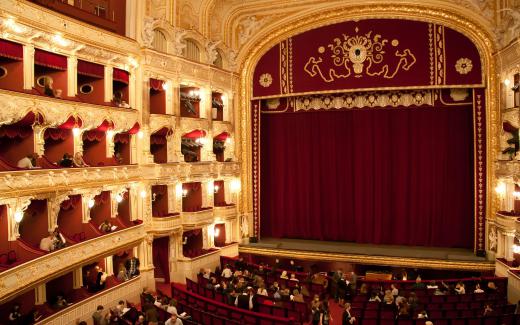At MusicalExpert, we're committed to delivering accurate, trustworthy information. Our expert-authored content is rigorously fact-checked and sourced from credible authorities. Discover how we uphold the highest standards in providing you with reliable knowledge.
What is the Marriage of Figaro?
The Marriage of Figaro, as Le Nozze di Figaro is known in English, is a opera buffa in four acts by the Austrian composer, Wolfgang Amadeus Mozart, who is also known for his operas Don Giovanni, Così fan tutte, and The Magic Flute, as well a symphonies and other works. The Marriage of Figaro was composed in 1785 with a libretto by Lorenzo da Ponte, who also penned the librettos for Don Giovani and Così fan tutte.
The libretto is based on the second of three plays by Pierre-Augustin Beaumarchais concerned with the character named Figaro. Paisiello had based an opera on the first play in the sequence, Le barbier de Séville, which Rossini also adapted to opera several decades later. Mozart was aware of the Paisiello production, but relatively few people know of it, while The Marriage of Figaro has become the favorite of all Mozart’s operas.

The premiere of The Marriage of Figaro took place on 1 May 1786 in Vienna, and many of the roles were taken by singers reprising their Paisiello roles. According to the reminiscences of Michael Kelly, the Irish tenor who played Basilio in the premiere, the effects were so wonderful that in the first full rehearsal, the entire company spontaneously broke into cheers for the composer.

The story of The Marriage of Figaro is set in eighteenth century Seville, at the castle of Count Almaviva in the space of a single day. The opera opens with Figaro, the Count’s valet, and Susanna, the Countess’s maid, who are engaged to be married. Their plans are complicated, however, by two things. The Count has designs on Susanna, and Figaro once borrowed money from Marcellina, promising to marry her if he defaulted on the loan, which he has. Marcellina has Bartolo, who holds a grudge against Figaro, backing her up.

The young man Cherubino, a trousers role — i.e., a male part played by a woman, enters and asks Susanna to use her influence with the Count on Cherubino’s behalf. The Count has just fired him for flirting with the Countess. When the Count enters, Cherubino hides, and when he is discovered, arrangements are made for him to join the army to keep him away.
In Act II of The Marriage of Figaro, Figaro and Susana persuade the Countess to play a trick on the Count so that he will be preoccupied, allowing them to get married without his interference. They lead the Count to believe that the Countess is meeting a lover and that Susana is willing to meet him. The plan involves sending Cherubino dressed as Susanna to fulfill this assignation, with the Countess waiting in the wings to surprise them and shame her husband. As Cherubino is being readied, the Count enters, and Cherubino hides again, jumping out the window upon the Count’s departure.
Act III begins with a revised plan of action: Susanna and the Countess will exchange clothing and the Countess will meet the Count. Figaro goes to court and, upon being held to his promise, protests that he cannot wed without his parents’ consent, leading to the revelation that Marcellina and Bartolo are, in fact, his parents. The Countess dictate a letter from Susanna to the Count, and Susanna gives it to him when two couples — Figaro and Susanna, and Marcellina and Bartolo — are presented to the Count and Countess for their blessing.
Act IV begins with a mistake that leads Figaro to doubt Susanna, and finds Basilio and Bartolo to back him up. Not being aware of the new plans formulated by the Countess and Susanna — they choose not to tell him — Figaro thinks that the Count is meeting with Susanna, when it is actually the Countess. This leads to mass confusion, until all is revealed, the Count begs the Countess’s forgiveness, and all ends happily.
AS FEATURED ON:
AS FEATURED ON:













Discuss this Article
Post your comments